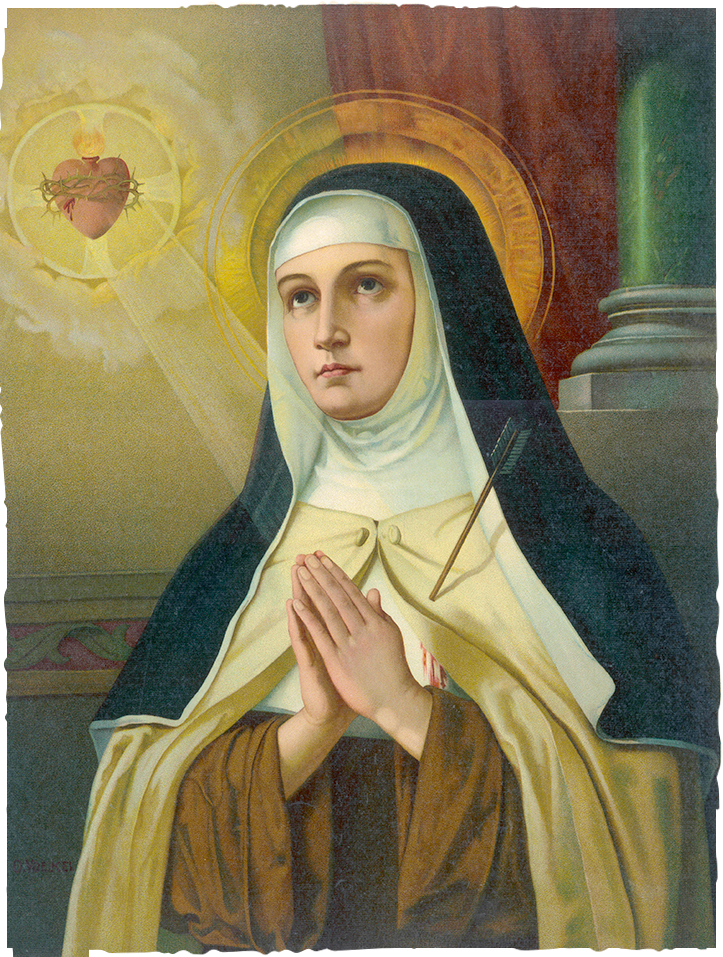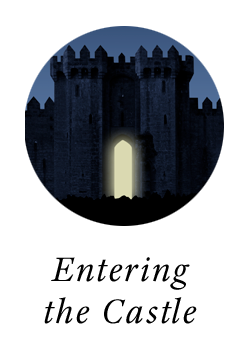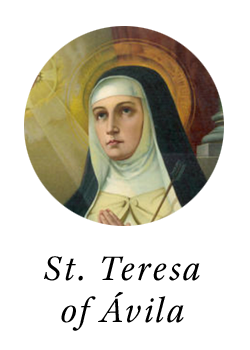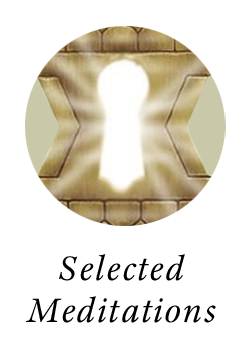ENTERING THE CASTLE
St. Teresa of Ávila

I believe that the divine is everywhere and exists within even the most intimate details of our lives. All that we experience today has its purpose in tomorrow’s events; sometimes, the purpose is not evident for years of tomorrows. Yet, God prepares you for your spiritual journey, no matter how complicated, painful, or demanding it might become. For this reason, patience, trust, and faith must become constants for you; you cannot, and indeed you must not, even attempt to believe you know what is best for you. The divine will reveal its plan for you; you have to be open to receive it. With this bit of advice, let me now share why and how I came to fall in love with Teresa of Avila, whose life’s work with the soul is the foundation of “Entering the Castle,” as well as my personal spiritual journey and practice.
After the sudden soul awakening in my office, I moved from my townhouse to an old Victorian that I had renovated…. My dreams and interior journey had become more mystical, as if I were being led into new spiritual territory. Even so, everything seemed normal on the surface: I was teaching, writing a new book, and maintaining all my other professional commitments. But nothing was the same behind the scenes. I was moving-or being moved-into another place.
As part of my teaching schedule, I founded an educational institute, CMED (Caroline Myss Education), which at first offered two programs, one on Sacred Contracts and another on Intuition and Mysticism. One winter weekend after my “light” experience, as I was about to begin my first lecture of a three-day workshop, a student asked, “What is your personal spiritual life like?” Normally, I would have given a terse answer, something like, “I pray,” followed by, “Next question?” since I have always been ferociously private, sharing only social stories and the like. But this time I decided to answer that question, even though my plans for that morning did not include my spiritual biography, but rather the lives of the Catholic mystics, St. John of the Cross, Ignatius Loyola, and Teresa of Avila; the afternoon was to be devoted to the Eastern mystics, beginning with my personal favorite, Rumi. But we took a brief detour into my personal beliefs.
The students wanted to know when I had first begun to believe in God, which always strikes me as a funny question. I have always believed in God; I have never had a moment or even a second of doubt. I have always believed in miracles; I grew up in a spiritual dreamland where the presence of the divine was everywhere. I have long had a mystical vision of the world, so teaching the mystics that day seemed natural.
As I moved from my beliefs into discussing the mystics’ lives, a student asked, “Aren’t seizures known as the mystic’s disorder?” Now, at this point, I hadn’t said a thing about my seizure. I was a little taken aback. “Yes,” I responded, “many mystics had seizures. Teresa of Avila passed out from them many times.” Then, inexplicably, I choked up. I suddenly couldn’t teach. I had never before lost my composure while teaching, but I did that morning and, crying, had to leave the stage. A colleague filled in for me for the rest of the morning as I sat on the side with a friend.
I felt odd, vulnerable, frightened. Something was different for me, within me, but I could not identify it. Was I going to have a second seizure? On the stage? I had no idea, but I was nauseated with fear.
That afternoon, though, I began the next session. I always teach standing up and moving around the dais, but this time I sat on a stool. I was holding a copy of “The Interior Castle”, by Teresa of Avila, even though I had intended to teach “Dark Night of the Soul”, by John of the Cross. I had grabbed the wrong book when I went on stage, but I didn’t want to move because I felt so fragile. I thought, Oh, well, it doesn’t matter. And I began my talk.
I said, “Teresa of Avila was a sixteenth-century Carmelite nun who . . .”
Suddenly, I felt a presence, a force near me. Then, I heard, “Daughter, follow me.”
It was the voice of Teresa. My immediate response was, “Do not let my students know we have never met, Teresa. Do not let them know.”
For the next three days, I taught “The Interior Castle” as if I had studied it all my academic life, when in fact I was only vaguely familiar with it. I followed Teresa into her Castle and, to the best of my ability, articulated the images and information of its interior for my audience of contemporary spiritual sojourners. That weekend, in front of all those students, God gave me a passion and I could do nothing but follow it. That weekend, too, I entered the interior Castle of my soul and began the work that became this book.
Following that workshop, I went home and immediately threw out every single page of seven chapters of a manuscript on which I had been working for months. …
Then and only then did I realize what I had done. Like returning from an expensive, long-overdue vacation in which I had wildly treated myself to little and big goodies, I came back down to earth, to the everyday reality and hard work of writing about an essentially ineffable experience. After my weekend of spiritual excess with Teresa of Avila, after that mystical, gale-force, soul-full workshop, I was alone in my kitchen, about to start writing a new book that I had not even conceived of two days ago. And I was about to rely on the guidance of a sixteenth-century Carmelite nun. In a prayer, I said, “I gotta tell ya, Teresa, I just put my career on the line. This better be real.”
Five minutes later, the mail came. In it was a letter from England from someone I did not know. Enclosed with the letter was a bookmark with a handwritten message on the back: “Caroline, I am praying for your health and protection each day. May God guide you with every step. With love and prayers, Colette. Thank you so much for lighting our way.”
The front of the bookmark, which I have before me even as I write this, is a picture of a lily pond. The message on the bookmark reads: “Let nothing disturb you. God Alone Suffices. Teresa of Avila.”
I had my proof. And I am never separated from that bookmark.
On another note, I have completely recovered my health. I was prepared not to be able to heal… to have to deal with a chronic disorder. I now know what it is to feel as vulnerable as a human being can feel. I was ready to become dependent on others’ care, which, for someone as independent as I am, was no comfort. Having to say, “If this is what I must accept, so be it,” can feel like chewing glass, but not being able to accept what you cannot change is like having to swallow those shards of glass. I know this to be true from the depths of my soul.
Out of all this, “Entering the Castle” was born. It is truly a work of my soul, as well as of the souls of all the people who gave me “Invisible” “Acts of Power.” This work, and my soul’s journey, could not have begun had it not been for them. I remain ever so grateful to all the people whose stories inspired that precious book. “Entering the Castle” is also part of a much greater spiritual awakening-an awakening of the collective soul of humanity.
More and more people are being drawn into the work of the great mystics of the Judeo-Christian and Eastern traditions. This yearning for the sacred cannot be satisfied by mainstream religions, which appeal mostly to our heads and hearts. As an evolving spiritual culture, we are now ready to meet our souls.
Yet, it takes great courage to get to know your soul. This is because, once you do come to know it-and engage its power and live according to its authority-the divine itself will come to call. Once you are conscious of your soul, you are likely to be “called.” Facing that call also requires courage because it can take you to both intensely light and intensely dark places.
Theresa of Avila’s Significance
As an abbess and a nun, Teresa was known for her beauty, charm, and administrative skills, and her take-no-prisoners form of spiritual direction. The physical facts of her life are these: Famous in her lifetime for her wisdom and visions, she was born in Avila, Spain, on March 28, 1515, and died on October 4, 1582. Her family were “conversos,” Jews who had publicly converted to Catholicism during the Inquisition. Teresa became the Patroness of Spain, was canonized a saint in 1622, and in 1970 was made a Doctor of the Catholic Church, the most respected title given to a scholar, theologian, or mystic for his or her contribution to Christian enlightenment.
Teresa’s spiritual biography is far more intriguing. Her intimate spiritual relationship with Jesus inspired many nuns to adopt the practice of wearing wedding bands upon taking final vows as a symbol that they were brides of Christ. Yet, like many mystics, Teresa did not begin her life with a burning desire to have a mystical relationship with God, or even to be a nun. As a young girl of twelve, she was sent to a convent by her father for education and discipline after the death of her mother, which had devastated her. During her eighteen months with those nuns, whom Teresa found particularly loving and spiritually devoted, she felt called to the monastic life. At the age of eighteen, most scholars agree, she entered the Carmelite Order of the Incarnation, against her father’s wishes. But later in his life, inspired by his daughter’s example, her father also became devout.
In her autobiography, Teresa dismisses most of the first two decades of her life as a nun, writing that she neglected God and was attracted to the social life in the convent. Spanish through and through, full of music, Teresa loved to play the tambourine and drums, sing, and dance. She also loved food-loved cooking it and loved eating it.
Although her prayer life was painfully frustrating, boring, and empty over those years, that changed just as she was entering midlife. At thirty-nine, Teresa had a classic mystical breakthrough, one that we could even call a conversion. Teresa was already a believer, of course, but her faith had not become experiential; it was mental, habitual, and governed by ritual. But on this particular day, Teresa experienced her first intense mystical encounter with Jesus while walking down the hallway of her convent. Pausing at a statue of Christ known as the “Ecce Homo,” Teresa fell prostrate on the floor, sobbing, as the pain of Jesus being flogged became real to her for the first time. In that moment, Jesus “incarnated” within her and she felt him in every fiber of her body and soul. When she finally composed herself, after weeping for hours, Teresa the mystic had been born.
From that moment on, Teresa had numerous mystical experiences, which she called “divine favors,” because one can never tell when God will visit. One can only be a willing recipient of a mystical experience, which is solely and completely determined by the divine. Her mystical experiences progressed to become increasingly cosmic, transcending any she had ever heard or read about-she was seen to levitate by other nuns, and also had indescribable out-of-body states and illuminations in which she was fully conscious of separating from her senses and transcending physical realities.
Teresa explodes the myth about mystics that, once God has called you, your life becomes one of suffering and poverty. In her case, and in other cases like that of the great Sufi mystic Rumi, God consumed Teresa and Teresa consumed God, yet they prepared the way for the rest of us to discover a rich feast for the soul.






